There were coyote tracks at the Missouri mine. They weren’t supposed to be there. No one understood how such a distant predator got in or how to keep it out. But that’s true about a lot of places in America these days.
We were wandering the ruins of Federal Mill Number Three, the largest lead mine in the US until its closure in 1972. For centuries, most lead came from Missouri. Ammunition for every war, toxic paint for every child’s classroom, noxious petrol for every parent’s car.
Lead spread from the heartland, made in America, and when we were poisoned, we were poisoned together.
Lead exposure makes you violent. It possibly created generations of psychopaths. But folks didn’t know that when Federal Mill opened in 1906. They knew the ground sparkled when they walked. They thought the earth was meant to be stripped down and sold for parts, because its bounty was infinite, and the country was new.
But lead was finite, like freedom. The mine closed after the minerals were extracted and the ground was useless and torn. A chart from the last day of operation stands in front of rusted towers, workers’ names frozen in the hour their world ended.
Missouri did what it always does in the face of self-made disaster: it turned the mine into a park. Federal Mill became the Missouri Mines State Historic Site. It has two museums and an ORV track nearby, where the ground is too toxic for straight hiking but still ripe for fun.
I’ve had a lot of good times in abandoned Missouri mines. I kayaked through one using a Hefty bag as a sea blanket and took a pontoon ride past a scuba diving pit in another. Missouri excels at turning wreckage into recreation. Our state has been living in the aftermath of the American Dream for a long, long time.
We are an Aftermath State of Aftermath People.
I had passed the remains of Federal Mill Number Three from the highway for twenty years. But I’d never gone inside, and it seemed like time. The battered landscape left behind beautiful ruins. As the economy erodes, new ruins lie in wait. I am sentimental about ruins not because of the past, but because they require a future. Seeing ruins means they haven’t won yet. You are still around to be a witness. I wanted to see the past before the future is mined to death too.
There are new miners in America now, mining your social security number and your privacy and your rights and freedom. Mining the Treasury, which they will pocket. Mining institutions for the last few patriots, but those resources were already scarce.
Mining Congress and coming up empty, because they already bought it. Checks and balances drift like a discarded receipt in the breeze. The real money is dark money, untraceable, but you can still see oligarch names on campaign contribution lists. They like to show proof of purchase.
In my deck of playing cards of Missouri State Parks — what, you don’t have one? — the Missouri Mines State Historic Site is the Ace of Clubs. One of four cards in the dead man’s hand.
Maybe it’s an in-joke about all that precious poison. Maybe I’m overthinking it. I overthink some things when I don’t want to think about others.
* * *
I was not the first to mourn America at a Missouri mine. That distinction goes to Henry Schoolcraft, the geologist responsible for Missouri’s lead industry.
Schoolcraft explored Missouri in the early 19th century, mapping its caves and noting its mineral abundance. Schoolcraft also explored Michigan, where he was appointed an Indian agent and married a writer named Bamewawagezhikaquay, also known as Jane Johnston, the granddaughter of an Ojibwe chief. After her death, Schoolcraft married another writer, a slave-owning virulent racist named Mary Howard, causing his mixed-race children to hate him.
Schoolcraft wrote guidebooks for an America struggling to define its identity as he struggled with his own. He died penniless during the Civil War, having watched the US government use his research to destroy the very people and places he depicted — everything from indigenous culture to Midwestern minerals.
Schoolcraft’s big hit was his 1819 work, A View of the Lead Mines of Missouri, because it made terrible men rich. But my favorite Schoolcraft work is his epic poem: “The Groans of Missouri.” Entranced by my fair state, Schoolcraft decided to write from the perspective of its extracted, exploited minerals. He gave each mineral a distinct personality and had them plot revolution against mankind.
The angriest is lead, who proclaims:
“My friends in Missouri, my kin and my compeers,
All smarting with pains, and all bathed in their tears;
After many long years of oppression and grief,
At length are encouraged to try for relief….
We were picked, and were hammered, bruised, injured, and broke,
And jostled in buckets, and smothered in smoke;
We were carried, like culprits, along in a cart,
And plunged in a furnace, and tortured with art….
And what is distressing beyond all our woes,
Our tears have turned gems in the chests of our foes;
Our blood and our groans have procured them delight,
And decked them with riches that dazzle the sight.
One only solace we have found for our woes,
‘Tis the bullets we’ve sent to the heart of our foes.”
Preach it, lead, preach!
This is but a fragment of the Schoolcraft opus. It is one of the strangest works I have ever read, and I am a connoisseur of weird shit. The poem ends with the minerals getting revenge through the 1811-1812 New Madrid earthquake: the southern Missouri quake so violent it caused the Mississippi River to flow backwards. Empire was allayed, the minerals rejoiced, due to the terrible clashing of stones.
Henry Schoolcraft was born a century and a half too early. “The Groans of Missouri” is like a rejected Blue Öyster Cult track or an ode from a loquacious geologist beatnik. Schoolcraft scholars hate the poem. I may be its only fan.
“The Groans of Missouri” could be the title of my autobiography, but that’s not why it resonates. It’s the wild-eyed wonder, the reverence for rocks, how he loves life more than money, or as he puts it, “bank-paper trash.”
I’ve spent the last few years collecting minerals from farms on lead mine land — the farmers will let you dig if you throw ‘em twenty bucks — and restoring them to beauty with a toothbrush and a chemical concoction. Quartz, barite, and — careful — cubes of galena, otherwise known as lead.
This might seem an odd way to spend the end of the world, but it makes sense to me. I am repairing the damage of Missouri’s dead dreams, giving history’s losers a chance to meet the sun, and show how bright they shine.
* * *
I was startled by the beauty of Federal Mill Number Three. The walls, long rusted, are streaked with color, and smashed windows gape like tiny caves. They remind me of the cliffs of Pictured Rocks National Lakeshore on Lake Superior, so named because of the variety of colors their minerals produce.
Coincidentally, Schoolcraft was the first person to map Pictured Rocks for the US government. True to form, he could not restrain himself from writing a dramatic poem in their honor:
“Their rocky summits split and rent,
Form’d turret, dome, or battlement,
O seemed fantastically set
With cupola or minaret,
Wild crests as pagod ever decked,
Or Mosque of eastern architect.”
Sure, why not? I can’t fault him for flights of fancy: that’s a survival skill when the world is razed. You need imagination to survive an Aftermath State, where you’ve long abandoned the idea of not being abandoned. You have to want to avenge nature, and reclaim the romance in the wreckage, or you will go mad in a much less appealing way.
You can collect lead, or you can load it.
In the geology museum at the mining site — where a ranger apologetically informed us there was an admission fee, a rarity in Missouri parks, and that it was four dollars — there is a room of rocks that glow in the dark. No one knows they do until the lights go out. They seem so ordinary — and then their powers emerge, neon defiance in a clear glass case. They look like the congregation of minerals Schoolcraft imagined in his poetic fever-dream.
I held my son’s hand in the dark, even though he’s too old for that. He knew I was sad and let me. I wanted him to see something miraculous but natural. I wanted him to look through a screen, not at a screen, and witness something true.
Beauty is in the eye of the beholder and the oligarchs are building mechanical eyes. What are algorithms but mechanical eyes, controlling everything you see, tailoring reality to a fake version of yourself, making it impossible to share a serendipitous sighting with another human being?
Outside the building, an American flag waved on a roped-off site, the earth too weak to hold the people of its nation. Signs everywhere told us we were in danger. Signs everywhere told us we were welcome to visit what solid ground remained.
Under our feet were the groans of Missouri. Above them were the mysterious coyote tracks. When I got home, I took out my Schoolcraft poem and jolted at the first line, about the very site on which we had stood:
“When wilds that were lately the panther’s retreat..”
I felt dizzy, the way you do from coming full circle one too many times.
* * *
Elon Musk is the product of a mining magnate. To the degree that he is a self-made man, it is because he made a powerful illusion of himself, and marketed it to other illusionists, none of whom value anything human.
Thievery has moved beyond the concrete schemes of past centuries and into a digital void that ordinary people do not know how to navigate — other than to identify what plutocrats stole from them.
And that our country is one of those things.
And that the earth is one of those things, and it screams as they mine it again — for contrived currency and artificial intelligence. For replacements for human beings as they work towards global depopulation.
We used to live on borrowed time, but now we live on stolen time, because the oligarchs are taking that too. They are deleting our data and records and history. The final step is deleting people, the last repositories of memory.
The faster this disaster happens, the slower moves my mind.
No official stops it. No one explains how such distant predators got in or how to keep them out. So do not fault me for visiting the past, when the people who inaugurated the destruction of the future at least had the decency to mourn it in a poem.
There is nothing I can write to derail this catastrophe that I haven’t written already. I am worn from warning. What is a warning, anyway, but a declaration of what you love and want to protect?
It’s not that my heart’s not in it. It’s that my heart is in everything.
* * *
Thank you for reading! I would never paywall in times of peril. But if you’d like to keep this newsletter going, please consider becoming a paid subscriber. That ensures every article remains open to everyone. I appreciate your support!
I could stare at these colors and angles all day long.
All photos taken at Missouri Mines State Historic Site in 2025. Isn’t that lamp pretty?

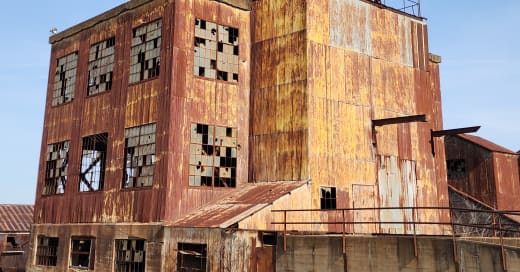



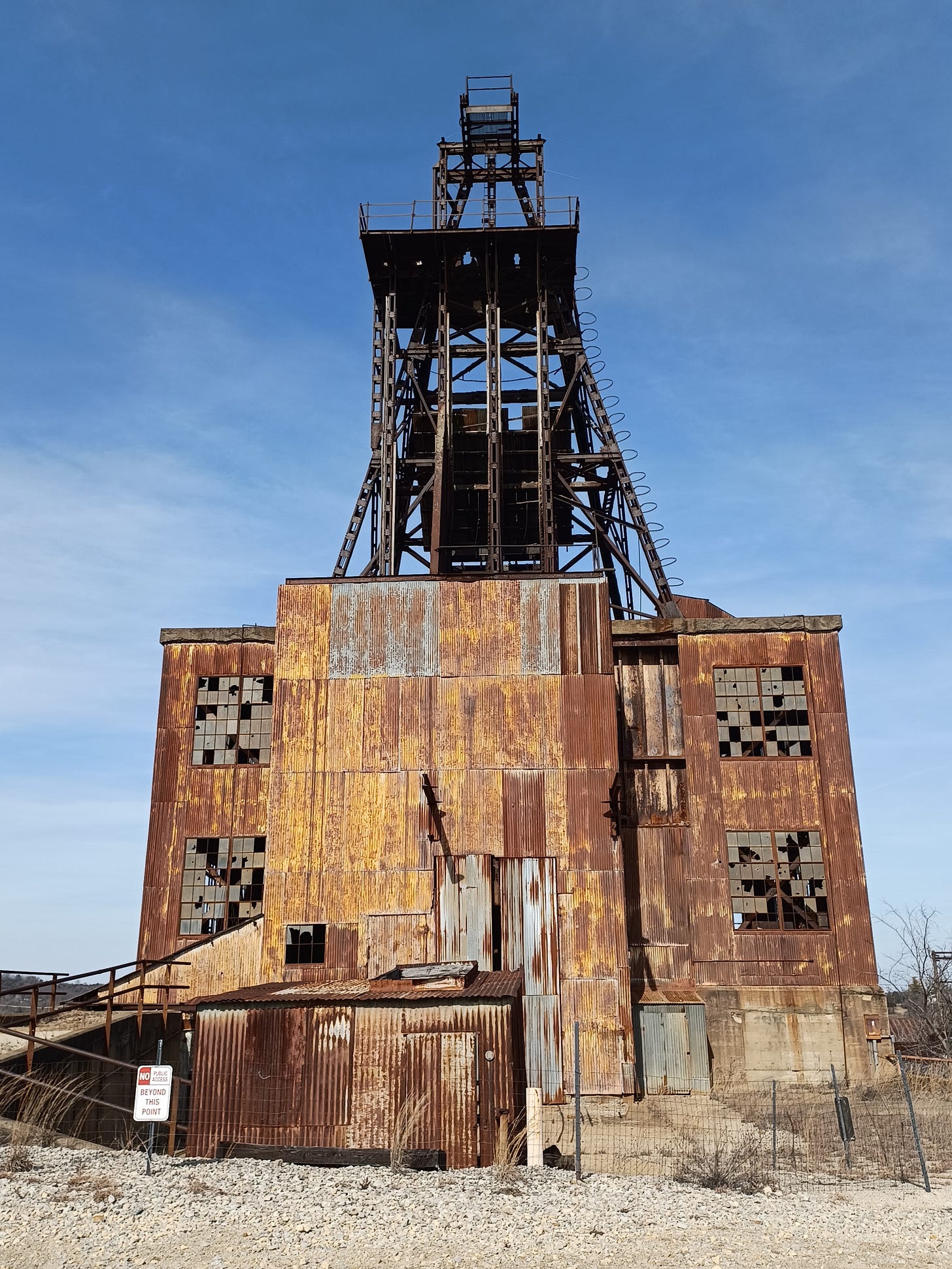
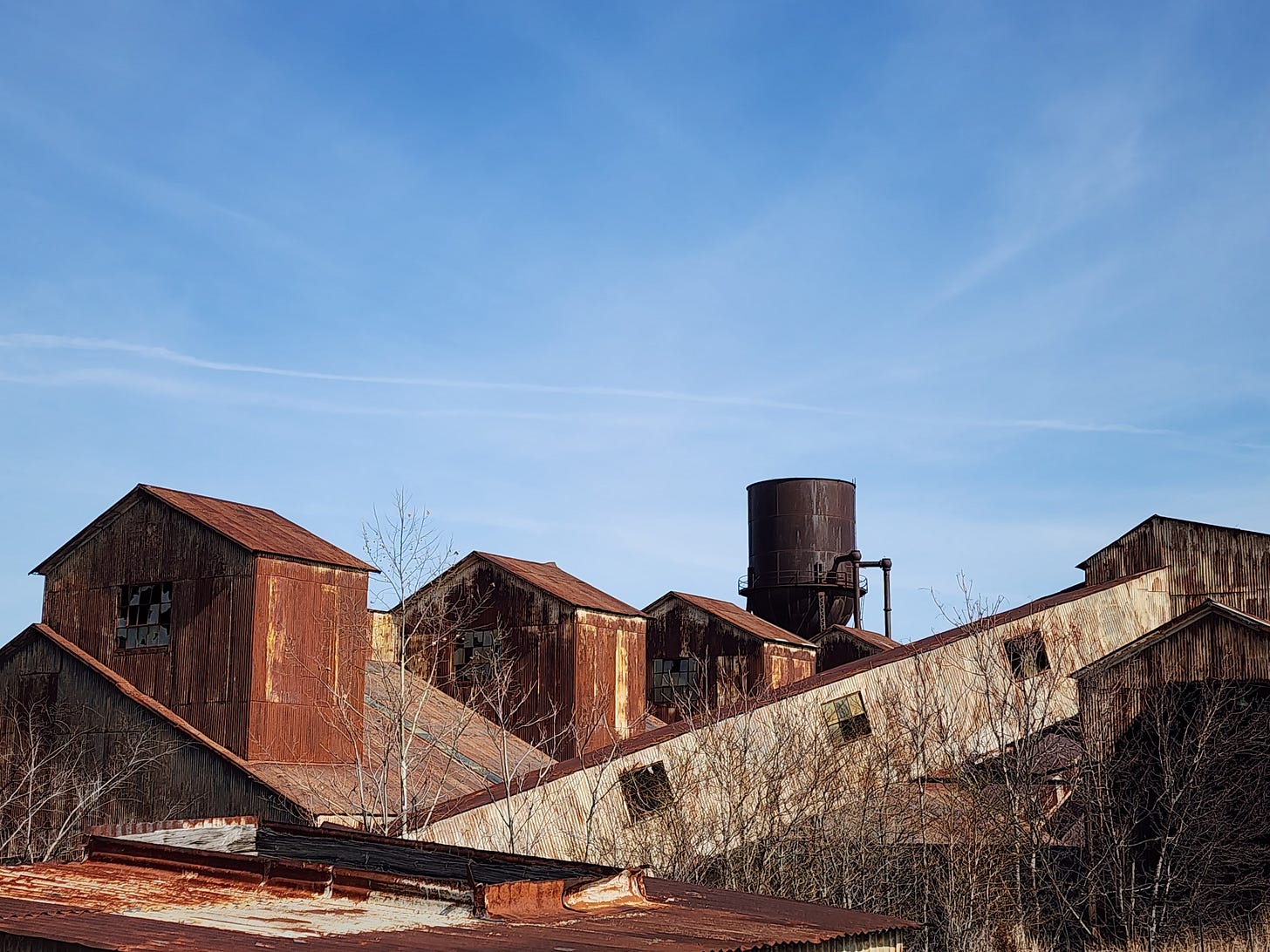
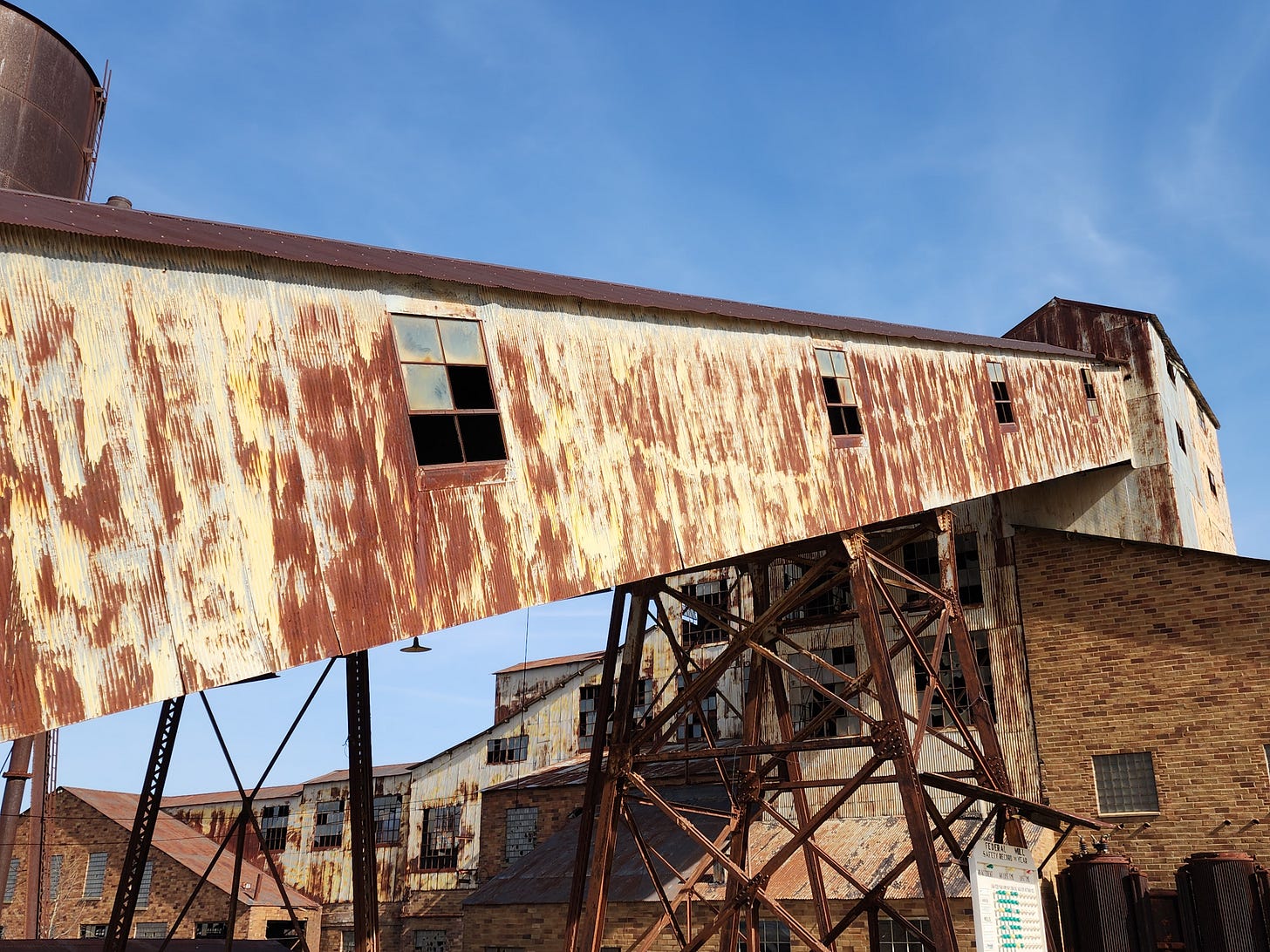

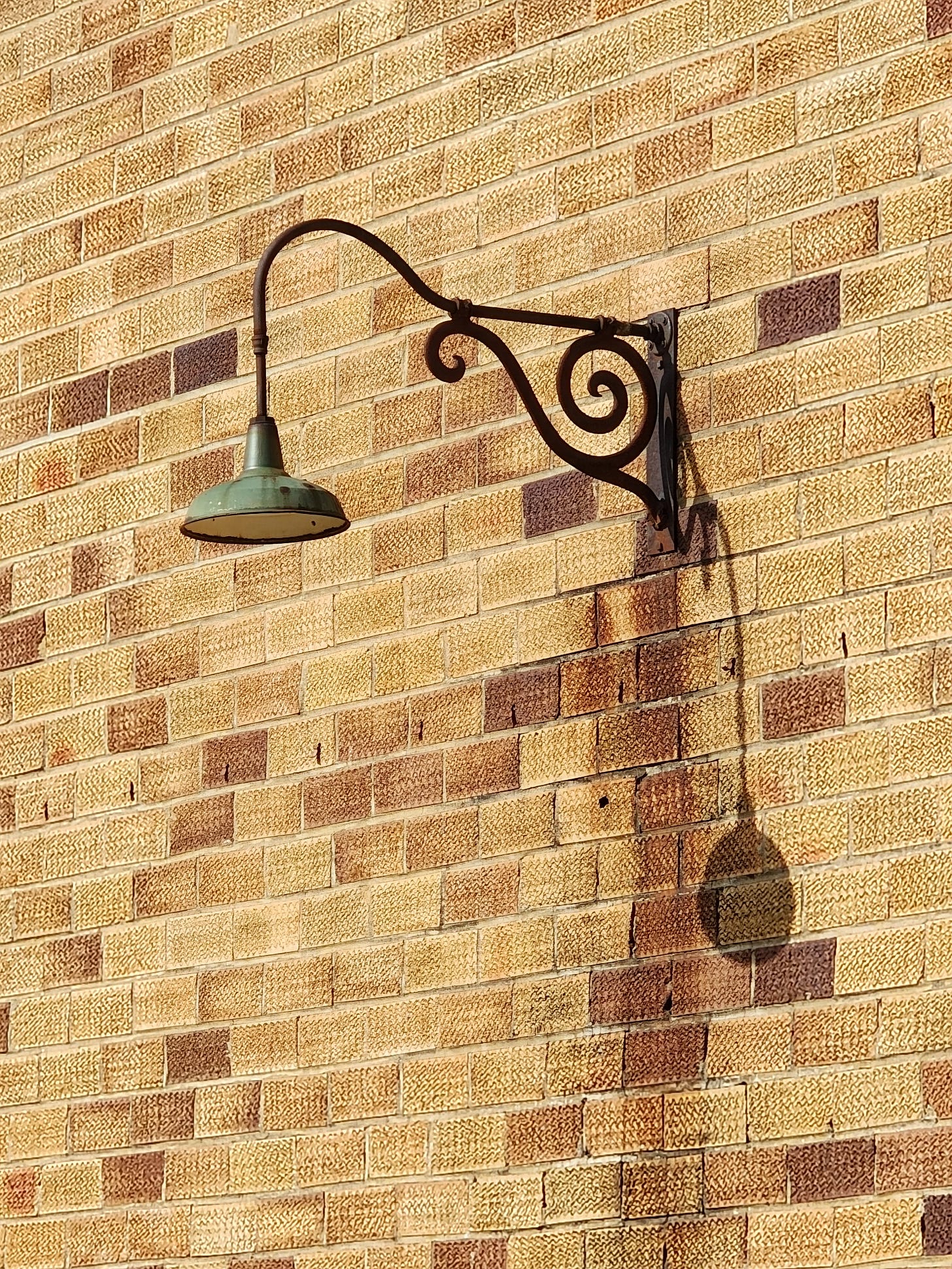
I really appreciate the way this post bobs and weaves from poetry to history to righteous anger. (You would be a great preacher.)
"Thievery has moved beyond the concrete schemes of past centuries and into a digital void that ordinary people do not know how to navigate ..." Oh man, is this true.
This is an extraordinary piece of writing. Beautiful and heartbreaking and true. What a strange time to be alive.